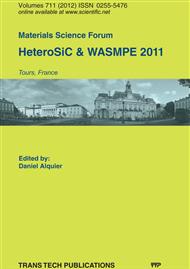[1]
1.E. Pippel, J. Woltensdorf, H. Ö. Ólafsson and. E. Ö. Sveinbjörg, Interfaces between 4H-SiC and SiO2: Microstructure, nanochemistry, and near-interface traps, Jour. Appl. Phys. 97 (2005) 034302
DOI: 10.1063/1.1836004
Google Scholar
[2]
K. C. Chang, N. T. Nuhfer, L. M. Porter and Q. Wahab, High-carbon concentrations at the silicon dioxide–silicon carbide interface identified by electron energy loss spectroscopy, Appl. Phys. Lett. 77 (2000) 2186-2188
DOI: 10.1063/1.1314293
Google Scholar
[3]
W. Lu, L. C. Feldman, Y. Song, S. Dhar, W. E. Collins, W. C. Mitchel and J. R. Williams, Graphitic features on SiC surface following oxidation and etching using surface enhanced Raman spectroscopy, Appl. Phys. Lett. 85 (2004) 3495-3497
DOI: 10.1063/1.1804610
Google Scholar
[4]
Y. Sasaki Y. Nishina, M. Sato and K. Okamura, Raman study of SiC fibres made from polycarbosilane, Jour. Material Science 22 (1978) 443-448
DOI: 10.1007/bf01160751
Google Scholar
[5]
A. Gavrikov, A. Knizhnik, A. Safonov, A. Scherbinin, A. Bagatur'yans, B. Potapkin, A.Chatterjee and K. Matocha, First-principles-based investigation of kinetic mechanism of SiC (0001) dry oxidation including defect generation and passivation, Jour. Appl. Phys, 104 (2008) 033508
DOI: 10.1063/1.3006004
Google Scholar
[6]
A. C. Ferrari and J. Robertson, Interpretation of Raman spectra of disordered and amorphous carbon, Phys. Rev. B. 61 (2000) 14095
DOI: 10.1103/physrevb.61.14095
Google Scholar
[7]
J. C. Burton, L. Sun, F. H. Long, Z. C. Feng and I. T. Ferguson, First- and second-order Raman scattering from semi-insulating 4H-SiC, Phys. Rev. B 59 (1999) 7282-7284
DOI: 10.1103/physrevb.59.7282
Google Scholar
[8]
W. Windl, K. Karch, P. Pavone, O. Schütt, D. Strauch, W. H. Weber, K. C. Hass and L. Rimai, Second-order Raman spectra of SiC: Experimental and theoretical results from abinitio phonon calculations, Phys. Rev. B 49 (1994) 8764-8767
DOI: 10.1103/physrevb.49.8764
Google Scholar
[9]
J. Schwan, S. Ulrich, V. Batori, H. Ehrhardt and S. R. P. Silva, Raman spectroscopy on amorphous carbon films, Jour. Appl. Phys. 80 (1996) 440-447
DOI: 10.1063/1.362745
Google Scholar
[10]
N. Radić, B. Pivac, F. Meinardi, Th. Koch, Raman study of carbon clusters in W–C thin films, Materials Science and Engineering A 396 (2005) 290–295
DOI: 10.1016/j.msea.2005.01.007
Google Scholar
[11]
Z. Y. Chen, J. P. Zhao, T. Yano, T. Ooie, M. Yoneda, and J. Sakakibara, Observation of sp3 bonding in tetrahedral amorphous carbon using visible Raman spectroscopy, Jour. Appl. Phys. 88 (2000) 2305-2308
DOI: 10.1063/1.1288160
Google Scholar
[12]
A. Das, B. Chakraborty and A. K. Sood, Raman spectroscopy of graphene on different substrates and influence of defects, Bull. Mater. Sci. 3 , (2008), 579–584
DOI: 10.1007/s12034-008-0090-5
Google Scholar
[13]
L. Ravagnan, F. Siviero, C. Lenardi, P. Piseri, E. Barborini, and P. Milani, Cluster-Beam Deposition and in situ Characterization of Carbyne-Rich Carbon Films, Phys. Rev. Lett. 89 (2002) 285506
DOI: 10.1103/physrevlett.89.285506
Google Scholar
[14]
A. Ferrari and J. Robertson, Raman spectroscopy of amorphous, nanostructured, diamond-like carbon, and nanodiamond, Phil. Trans. R. Soc. Lond. A 362 (2004) 2477–2512
DOI: 10.1098/rsta.2004.1452
Google Scholar
[15]
J.R. Shi, X. Shi, Z. Sun, E. Liu, B.K. Tay, S.P. Lau, Ultraviolet and visible Raman studies of nitrogenated tetrahedral amorphous carbon films, Thin Solid Films 366 (2000) 169-174
DOI: 10.1016/s0040-6090(00)00732-x
Google Scholar
[16]
P. Borowicz T. Gutt, T. Małachowski, M. Latek, Carbonic inclusions on SiC/SiO2 interface investigated with Raman Scattering, Diamond and Related Materials 20 (2011) 665-674
DOI: 10.1016/j.diamond.2011.03.019
Google Scholar


